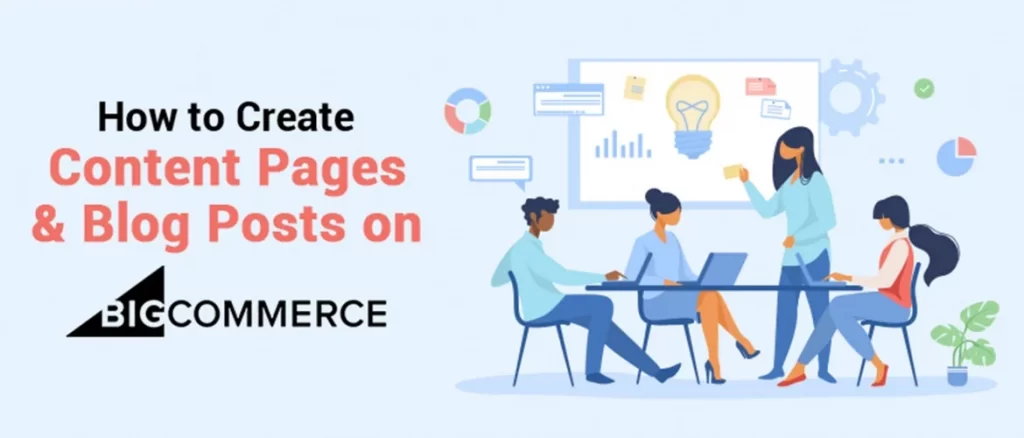Bigcommerce is a robust eCommerce platform for building an eCommerce store. Its user-friendly interface allows small and large businesses to create, manage, and optimize their online store.
Bigcommerce also offers a wide range of features and services to start and grow their online store and make it easier for retailers to sell their products online.
Like the other online platform, Bigcommerce is also designed with many SEO tools that help you to generate traffic quickly and rank your website in searches. To perform well, it’s important to optimize your online store and know the strategy of Bigcommerce SEO.
In this article, we will discuss Bigcommerce SEO and how to perform On Page SEO for your Bigcommerce Store.
Why is SEO Important?
SEO is Important because the majority of users use search engines so it is important to rank on the SERP (Search Engine Result Page) to drive more visitors to your online store. And, SEO enhances the overall user experience and usability of a website.
SEO gives you an edge over your competitors. Suppose, 2 websites are selling the same thing, and when a customer searches for the product, SEO optimized website comes first. This means the chances of getting sales will increase.
What is ON-Page SEO?
On-Page SEO refers to the practice of optimizing webpages in order to improve their position in search engine rankings and earn organic traffic. It includes optimizing your headlines, HTML elements (title, meta, and header), and images in addition to posting relevant, high-quality content.
Additionally, it entails ensuring that your website exudes a high degree of knowledge, authority, and credibility.
Best Practice of Bigcommerce On-Page SEO
Step-1: Keyword Analysis
Keyword research is one of the most important parts of SEO. There are hundreds of free and paid keyword analysis tools available online. Pick the best tool and search with your product name.
After searching, you will get an idea about relevant keywords, search volume, and keyword difficulty (KD). Now, you need to analyze them and select relevant keywords that have good search volume and low keyword difficulty (KD).
For example, we searched with night vision sunglasses which are our main products. Now we have seen that the tools are giving some important data against this keyword like suggested keyword, keywords difficulties, search volume, and the latest date.
For night vision sunglasses, we have seen that the search volume is 600 and KD is 8 in the past 5 days. This means most of the sellers are using this keyword. So if you focused on this keyword, then it’s difficult to rank. Before choosing any keywords, you need to do an in-depth analysis and definitely you need to use all the high-search volume keywords but in a different way.
Step-2: Optimize Product Name
Once you’ve chosen a keyword, It’s time to start using your chosen keyword. First, put the keyword on the <H1> heading tag which is the product name so we need to place the keyword on the product name.
Step-3: Optimize Product Description
Now jump into the product descriptions. Here, we need to write a heading tag <H2> and put the keyword properly. After that, place the keyword on product descriptions as well. And the most important thing is we need to place the keyword at the beginning or in the first sentence of the product descriptions.
NOTE: Try to write as much as content you can. Describe your product features and benefits in detail so that a visitor can spend more time on your website. Don’t forget to write quality content. Keep in mind that content is king.
Step-4: Optimize Product Images
Sometimes we skip the most important part of On-page SEO. It is very important to optimize your product image. Because google or other search engines can’t read your images but they can read the image “alt” text. So, we need to place our targeted keyword on the image alt text.
Step-5: Optimize Page Title
The page title is one of the most crucial factors that Google and other search engines consider when determining what is on a web page. It appears at the top of the search engine results page for your website (SERPs). So, we need to put our targeted keyword on the page title.
Step-6: Optimize Page URL
Google and other search engines analyze the text of a web page’s URL to determine its content. For that, you should use your targeted keyword or phrase. After each word give a hyphen (-) to separate them.
Step-7: Write Meta Description
Prepare quality meta descriptions about your product within 150 to 160 characters and place your keywords on the meta descriptions.
If you have completed all the steps properly now save them by clicking on the Save button.
In short,
- Find a long-tail keyword
- Choose a keyword that has good search volume and low KD
- Use high-quality attractive images
- Write reader-friendly contents
To conclude, On-Page SEO is a set of techniques used to optimize a website for search engine rankings. It is an important part of any SEO strategy and involves optimizing elements such as title tags, meta descriptions, headings, internal links, images, and content. By following best practices for On-Page SEO, your website can rank higher in search engine results pages and increase visibility.
We hope that you understand the full process and are able to do On-page SEO on Bigcommerce by following this guideline. Still, if you need any further assistance, feel free to let us know in the comment box. Our SEO specialists are always there for you to reply to your queries.
If you want to know about other eCommerce marketplaces please contact us here at www.ecomclips.com



